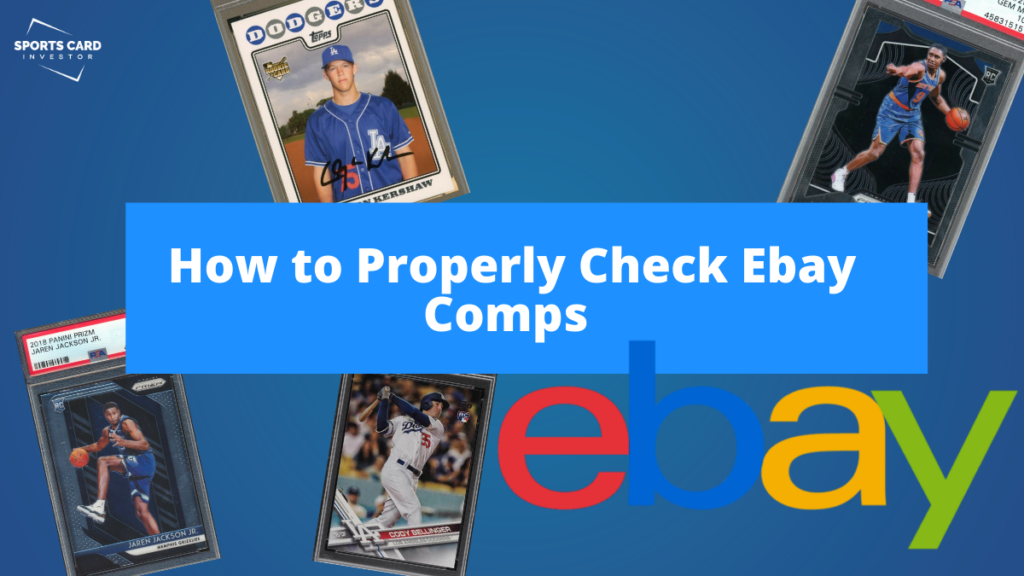
How to Properly Check Ebay Comps
This guest post came through our Article Submission Program. Thoughts and opinions are those of the author.
Introduction
Using eBay to understand the value of a card by looking at completed and sold listings is a Hobby 101 lesson. For most of us, it’s second nature. You pull open eBay, type in the card you’re looking for, select completed and sold listings and you move onto the next one.
As cards have continued to explode in values, the way we check comps (comparison card prices) requires a little more research. For those that need a refresher on basic comp checking, I’ll walk through an example card of how to do that and what you need to do next to avoid getting insufficient data.
Card prices are changing every day. No matter how knowledgeable you are, it just takes one auction or ‘buy it now’ to completely reset a market. If you’re in the heat of an auction, it can be stressful to figure out comparable pricing and bid the right amount.
I was recently bidding on a Carson Wentz 2016 Rookie Prizm PSA 10 because I’m a big Eagles fan and noticed his card was starting to move up in value. Before I bid, I did my normal comp check process.
I opened up eBay.com, typed “Carson Wentz 2016 Prizm PSA 10” in the search bar and check off “completed items” and “sold items” on the left-hand bar:
I noticed the card getting progressively more expensive and dropped a $500 bid near the tail end of the auction.
Then it hit me.
I forgot to look for shill bidders in my comps!
A shill bidder is someone who more than likely owns a particular card, creates a brand new eBay account and either bids up the price of a card on an auction, or clicks the Buy it Now button on a high price but never pays the seller.
[adcards]
In my humble opinion, this is the biggest problem in the hobby. If new people don’t know how to look for this, they’ll buy an $800 card only to realize it’s worth $400. Even in this market where card prices skyrocket, it’s a poor experience that will cause people to leave the hobby.
To take your comp analysis a step further to avoid false positives, you need to dig more into the data.
Start by clicking “Auction” at the top of the results page after selecting completed and sold items:
This will allow you to find cards sold via auction and dive into their bids:
You can see 28 bids is hyperlinked, click on that.
Once you do, you can see the bid history, and you can identify eBay users with 0 feedback:
You can see that there were two bids made by buyers with (0) feedback. This doesn’t always mean it’s a fake account, as new people enter the hobby every day, and the bids are usually much higher than $10 on the last price, but you want to keep an eye on this.
You can also look at current auctions bidders and bid history:
After clicking on “10 bids” you’ll see this:
*Note bidder 9***2 with (0) feedback
$535 to $680 is a pretty significant jump, so we’ll want to click “Show automatic bids” to see if that jump was due to a competing bid:
In this case, a user with decent feedback was in competition with the 0 feedback user, bidding the item up, but it’s still unclear as to whether or not 9***2 is a real account.
This creates a real challenge for both a buyer and a seller. What is this card worth? Is it really $690 or did a shill bidder bid against someone real to help boost the price for a card they probably own.
Unfortunately, it’s nearly impossible to tell.
The best next step you can take is to click into the item to see if it’s been relisted. The majority of Carson Wentz Prizm sales have not been relisted, but it could take up to a week of a seller waiting for payment before doing so.
Typically, someone will “purchase” a card at a higher price than market value to drive up the prices of the same card in other auctions. They won’t pay the seller, forcing that person to relist the item at a later date.
To combat this and make sure you’re paying fair market prices, take the following steps:
- Look at multiple sold listings for comps
- Check auction bid history for zero feedback bidders
- Check to see if the same user is bidding up multiple auctions
- Check for relisted items
- Ask for help
If I’ve learned anything in this hobby, it’s that people are willing to help. If you aren’t sure about a card price and suspect shill bidding, ask someone in the Discord chat and on Instagram. And if you’re buying a lot of cards, consider Geoff’s market movers tool to help remove some of the noise from completed auctions with bids from low feedback buyers!
Many folks often forget how important it is to check comps and get a good understanding of the current fair market value of the card they are going after. If you check recent comps on cards, I’m sure it can help lower the buy-in cost of future purchases. If you have interesting ways to check comps or compare prices, we would love to hear from you.
Ready to take your sports card investing to the next level? Join our Membership Program now for card picks, analytics, premium community access and much more!






